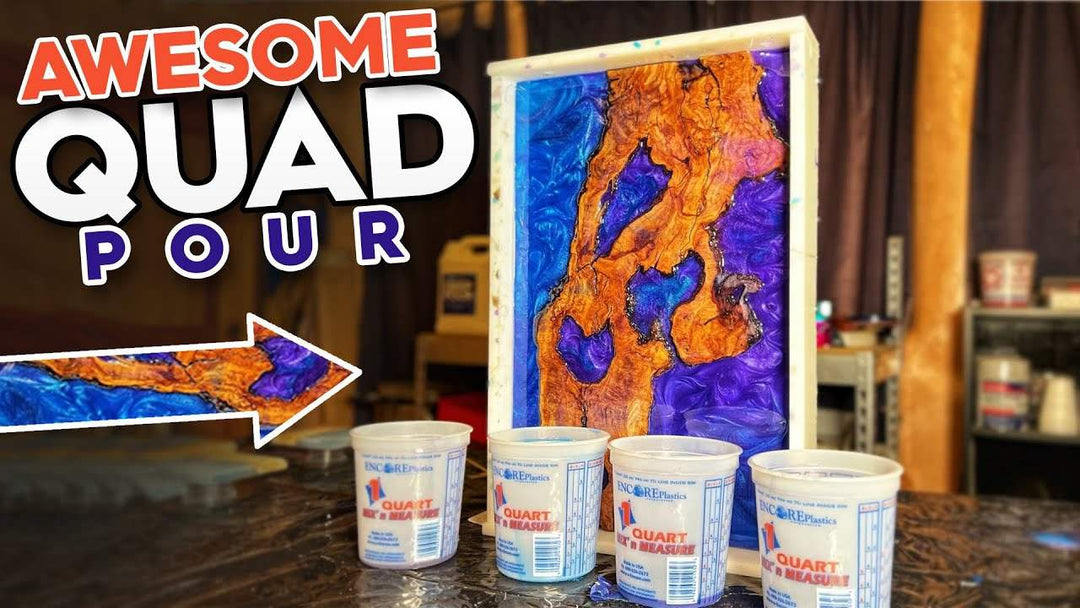
Layering Epoxy For Woodworking Perfection l Step-By-Step Guide
Epoxy and wood make an incredible team! Let’s go over some basic tips and tricks on how to use epoxy and resin for woodworking, whether you’re using our deep pour, art resin, or tabletop!
Skill Level: Beginner/Intermediate/Expert
Estimated Working Time: N/A
What You’ll Need:
- Upstart Epoxy Deep Pour Resin
- Upstart Epoxy Table Top Resin
- Upstart Epoxy Powdered Pigments Set
- Nail Gun
- Tyvek Tape
- Silicone
- Slab Router
- Planer
- Sander
Epoxy and Resin for Woodworking
What makes our deep pour epoxy resin such an awesome product for woodworking is that you can pour up to two inches of it at a time! The volume of this epoxy gives you the ability to work on projects like dining room tables, coffee tables, and much more. It gives you the freedom and flexibility to pour more and create bigger projects.
As for art resin, this one is a really fun epoxy to use, because it's perfect for smaller items like trinkets, charms, pendants, ornaments, and other items. It's versatile, multifunctional, and can even be used in place of tabletop if necessary. You can use it to do flood coats, which we often do with coasters.
Another reason epoxy resin is great for woodworking is that the working time of it is 35 minutes. That's really great, especially if you're doing layered pours, if you want to create swirls, or if you want to do a clear pour that you can later add color to with our mica powders. We guarantee you that mica pigments and art resin are ideal when used together!

More Resins for Woodworking
And last, but certainly not least, let’s talk about tabletop epoxy resin. It’s another versatile epoxy that you can use to create beautiful and stunning projects such as charcuterie boards, pendants, tables, and pretty much whatever you want to make! You can use it for flood coats or seal coats as well, which will preserve that piece forever.
Now we can start working on today’s project. First things first, we want to prepare our form for success, by using a nail gun here to pop the sides into the mold we constructed. After we're done doing that, we line the mold with Tyvek tape and add silicone to the top and bottom to prevent leaks. This step will also help level your molds, because if the mold isn't level, then the product isn't going to be level. An unleveled project is harder to sand and plane, so try to avoid that!
Next, get some hot glue and glue the pieces of wood to the form itself- this step is optional, but perfect for those who don’t want to use weights to keep their wood down. The purpose of both of these methods is to prevent your wood from rising up when you pour your epoxy.
After pouring over two inches of deep pour epoxy and allowing it to cure, it was time to refine our piece for success. It's always good to clean up your work before considering it finished folks, because working with epoxy and wood does get messy! trust me, it gets real messy. Whether you plan to take off the high points or sand to perfection, you always want to go over the entire project to avoid any scratch marks in your wood or any other imperfections.

Start Using Epoxy Resin for Woodworking
It’s worth it to go the extra mile and get your slab router and planer to get the refined look you want, especially if you plan on selling your work. We chose the slab router method here, which will keep your piece super flat, especially when you're laying it in the mold, because you don't want too much epoxy to get underneath it. After we got the desired look, we were all done! Another perfect project.





